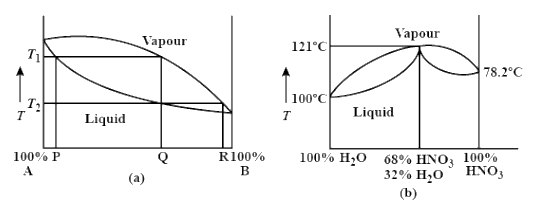Question
Question: What is the result of distilling a mixture of 80% \(\text{HN}{{\text{O}}_{3}}\) and 20% \({{\text{H}...
What is the result of distilling a mixture of 80% HNO3 and 20% H2O?

A. Pure H2O and azeotropic mixture can be separated.
B. Pure H2O and HNO3 can be separated.
C. Pure HNO3 and azeotropic mixture can be separated.
D. None of the above.
Solution
Azeotropic mixture is that solution in which the two or more solutions are mixed which have a similar boiling point and they are also miscible. The azeotropic mixture can be separated by applying a proper method.
Complete step by step answer:
- In the given question, we have to tell the result of the distillation of a mixture of 80% HNO3 and 20% H2O.
- As we know that the azeotropic mixture is the mixture of two or more liquids which have the same boiling point.
- Due to miscibility of the liquids it is hard to separate the azeotropes mixture by simple distillation.
- So, to separate the liquid present in the azeotropic mixture we use azeotropic distillation in which the addition of the reagent takes place.
- The addition of the reagent causes the change in the bonding of the liquids due to which they become immiscible
- So now they can be separated easily.
- That's why when the mixture of 80% HNO3 and 20% H2O undergoes distillation, then we can achieve pure HNO3 and azeotropic mixture.
- But to achieve the pure water from this mixture is difficult because of very less percentage of it.
So, the correct answer is “Option C”.
Note: Ideal solutions cannot form the azeotropic mixture because they obey Raoult's law. According to Raoult's law, the partial pressure of the solution with volatile solute is the product of the pure component's vapour pressure and the mole fraction of the component.
